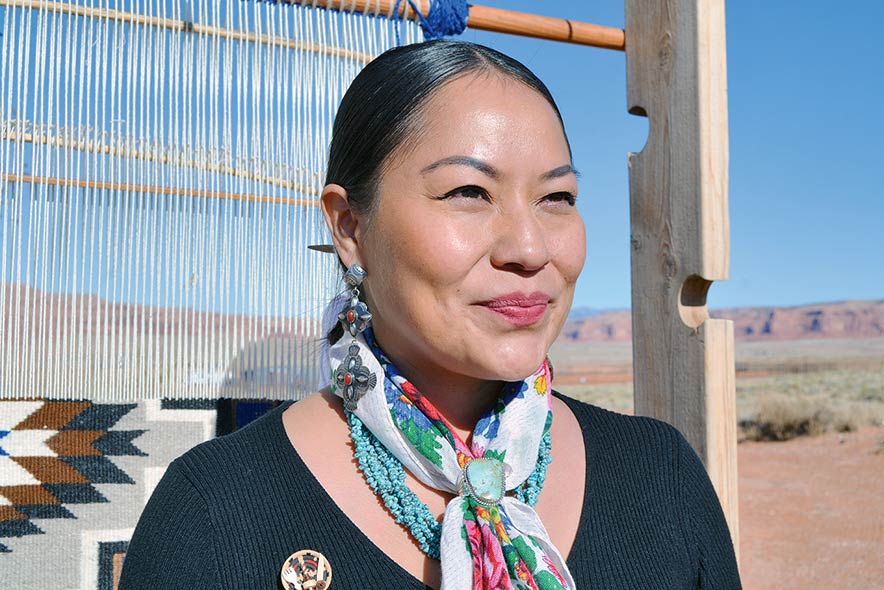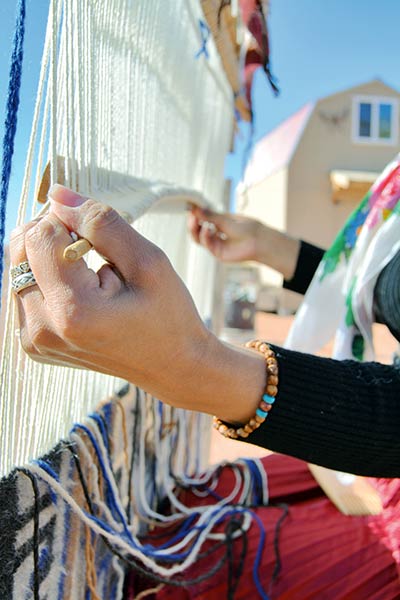
Young weavers set out to revitalize Diné culture

Navajo Times | Holly James
Tasheena Littleben looks out into the horizon at her home in Rock Point, Ariz.
ROCK POINT, Ariz.
This part of the Navajo Nation has been an area that has produced some well-known weavers generation over generation.
In recent years, the area has seen an emergence of younger generation weavers who are making their mark and ensuring the Diné culture of weaving is thriving.
Tasheena Littleben, 35, was born in Shiprock. She is Tł’ááshchí’í and born for Kinyaa’áanii. Her maternal grandfather is Tódích’íi’nii, and her paternal grandfather is Bit’ahnii.
Littleben is one of 11 children – five sisters and six brothers. She grew up in Rock Point, Arizona, where she learned to weave from watching her mother, Caroline Nez. In this area, about 18 women on the Littleben side of the family are currently weavers.
Littleben’s first rug was completed around age seven. She practiced for a few years until age 12 when the family moved to Phoenix. Shortly after becoming an adult, she moved to Nevada, where she lived for about 15 years.
When the pandemic halted the world in 2020, Littleben embraced it, received it as a calling, and began her return to Dinétah. As Littleben reflected on the duration she has been away from the loom since leaving as a child and now a grown woman, a mother, there were a lot of moments of self-doubt in her decision to get back into weaving as well as deciding to pursue its full time as her mother did before her.
Being away from it for so long, she felt she lost connection to it. However, in the heart of trying to weigh and settle these doubts, a picture appeared.
Getting settled at home back in Rock Point after the move from Nevada, Littleben came across a photograph. In the picture were her mother and herself as an infant sitting alongside her mother’s loom. Even at that young age, still in diapers and bottle in hand, she keenly watched her mother weave.
“Finding that picture surfaced at the right time,” Littleben said.
Taking a few moments to examine the picture, she fondly remembers the years of wonder, inspiration, and the powerful feeling of connectedness and belonging.
“At that moment, I offered gratitude and accepted the reassurance. I knew that was my destiny. This is what I was destined to do,” Littleben said.
Shortly after the picture emerged, Littleben began her first piece, representing her homecoming and return to weaving. Her loom holds a sense of foundation for her. She picked the cedar from the mountains, and her father helped construct the loom.
The beginning of the piece was emotional. A lot had surfaced with each yarn placement, each movement as it spoke to her. She said she released a lot of what she had been carrying internally over the years. Through the weaving, she could feel free and let the teachings motivate her. She completed her piece and gifted it to her son as a keepsake for the family.
Traditional techniques

Navajo Times | Holly James
Tasheena Littleben mindfully adjusts the batten and shuttle stick. Littleben explains weavers use their hands through every process.
“Having available resources here on the Navajo Nation is vital in keeping our culture alive,” Littleben said.
Littleben has taken classes from local organizations that share the same efforts to revitalize the culture. She is learning the process of organically growing her plants to use as dyes to incorporate into her weavings. Littleben explains, without resources such as these, we rely on elders to teach, but so much has been lost over the years, so it is critical to support, fund and have programs such as these, adds Littleben.
Littleben is inspired by some of her neighboring weavers like Tyrell Descheny and The Glasses siblings, Naiomi and Tyler.
“I am learning so much of the old ways, the traditional ways of weaving,” Littleben said. “Tyrell, Naiomi, and Tyler really are committed following the traditional way of weaving, and I am grateful to learn from them and also keep it going.”
Fellow weavers
Tyrell Descheny, 29, whose clans are Dziłghą Deeshchii’nii, Tł’ááshchí’í, Kinyaa’áanii, and Ta’neeszahnii, also from Rock Point, is a self-taught weaver.
Descheny remembers he was first introduced to weaving through his Navajo culture class in elementary school. The looms were made from cardboard for every student, and there was an education on all the tools used to weave. He feels that this is where his interest in weaving came about. However, it wasn’t until about five years ago he really took the initiative to weave.
“As Navajo, we are always told, ‘T’áá Hwó Ajít’éego,’” Descheny said. “This Navajo saying loosely translates it is up to you. So, this is what I did and fully went into honoring the traditional aspects of it. This is how it was done before me; this is how it should be done after me.
“Revitalization the culture of weaving has to start with us,” Descheny said.
Descheny said weaving would always be here but needed a zestful and determined heart to keep the art alive.
“It has always been here; it is just us that have the lack of determination and dedication to truly show its full potential when it comes to Diné weaving,” he said. “I feel that with social media, our generation has an advantage to reach and educate a wide audience.”
Descheny says that through his social media platforms, he receives many messages of support and positivity from followers worldwide. He shares that people are intrigued and want to learn the cultural side of Native art so it can be honored and respected.
“We can showcase who we are, where we are from. We can tell our own story,” Descheny said. “Most people recognize our weaving as one of our main trademarks as who we are as Diné.”
Descheny said he’ll sometimes turn off the lights, light his kerosene lamp, and do his weaving. Doing so helps him better understand what his nálí must’ve experienced.
“I think of my shinálí often when I weave. If they can do it, why can’t we?” Descheny asked. “I weave to get a better understanding of the elements they endured without the luxuries and conveniences we have now. It is a way for me to connect to harness that and utilize that in my weaving.”
Descheny has known of the Littleben’s weaving for a long time. He adds that he looks up to the Littleben family, who weave.
“I admire all of the Littleben weavers,” he said. “They do such amazing work and unique and nizhóní designs.”
Naiomi Glasses became a worldwide social media sensation when she shared videos of herself skateboarding on the rocky terrains of the Navajo Nation. Glasses, who is 25, was born in Mesa, Arizona. She moved to Rock Point at the age of 12.
Glasses is a seventh-generation weaver who started in her early teens finishing her first rug at 18 years old. She was fortunate to have received a lot of teachings from her grandmother and her older brother Tyler Glasses, Jr. Tyler, 34, has won many awards and ribbons for his pieces and shares the importance of following the traditional ways of weaving.
“It is refreshing and uplifting to see this reemergence,” Ms. Glasses said. “Not only just in weaving but also in all of the art that we Dine produce. So many younger generations are taking on the craft of the silversmith, sash weaving, and other traditional crafts. We are a creative culture and have a wide variety of talent.”
Glasses shares Littleben’s thoughts on the importance of supporting organizations or individuals who offer classes and says, “These teachings can ensure were preserving our culture”.
Learning how to market
The common resources Diné use to sell their work are trading posts, direct sales, or even auctions. Littleben aspires to help her fellow weavers set a standard or formula for marketing their pieces. She wants to educate fellow weavers on the business aspect of it, so they are compensated fairly and change the dynamics and relationships with trading posts.
“We have sold our culture, and we have given up who we are to the trading posts,” Littleben said.
For hundreds of years, Diné weavers have settled for tiny fractions of the true worth of their work. Traders tend to purchase pieces at meager amounts and sell at high costs making a tremendous gain.
The trader gains the profit, and, during this process, most traditional and cultural meanings and history are lost. These pieces end up as décor, framed, or shown as conversation pieces wherever they travel. Most trading posts have taken some control of Diné designs, shifting them away from traditional designs to appease a more commercialized audience.
“Weaving is medicine,” Littleben said.








 Highway 264,
Highway 264, I-40, WB @ Winslow
I-40, WB @ Winslow